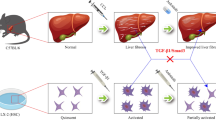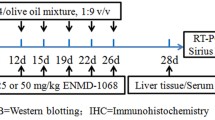Abstract
The expression of epidermal growth factor (EGF) is increased during liver fibrogenesis, and EGF receptor (EGFR) antagonist could attenuate liver fibrosis. Since EGFR is highly expressed by hepatocytes and cholangiocytes in cirrhotic liver, whether hepatic stellate cells express EGFR in response to EGF still needs exploration. Although EGFR antagonist could attenuate liver fibrosis, many ligands with EGF-like domains, besides EGF, can function through EGFR. Whether specifically blocking EGF could attenuate bile duct ligation (BDL)-induced liver fibrosis has not been revealed. BDL induced biliary infarcts and matrix deposition in mouse liver, and EGFR was expressed and phosphorylated by α-smooth muscle actin (αSMA)-positive myofibroblasts. LX-2 cells expressed EGFR, and these receptors were phosphorylated in the in vitro culture system. Growth curve and cell cycle analysis revealed that EGF could enhance cell proliferation of LX-2 cells. In addition, administration of EGF antibodies markedly reduced the EGF level in serum and the deposition of extracellular matrix in the liver of BDL mice when compared to IgG administration. Administration of EGF antibodies also reduced the phosphorylation of EGFR and the percentage of Ki-67-positive or PCNA-positive liver myofibroblasts of BDL mice when compared to IgG administration. Therefore, activated hepatic stellate cells express EGFR, thus being responsive to EGF signal, and administration of EGF antibodies could attenuate liver fibrosis by restricting the proliferation of myofibroblasts.





Similar content being viewed by others
References
Fuchs BC, Hoshida Y, Fujii T, Wei L, Yamada S, Lauwers GY, McGinn CM, DePeralta DK, Chen X, Kuroda T, Lanuti M, Schmitt AD, Gupta S, Crenshaw A, Onofrio R, Taylor B, Winckler W, Bardeesy N, Caravan P, Golub TR, Tanabe KK (2014) Epidermal growth factor receptor inhibition attenuates liver fibrosis and development of hepatocellular carcinoma. Hepatology 59(4):1577–1590. https://doi.org/10.1002/hep.26898
Georgiev P, Jochum W, Heinrich S, Jang JH, Nocito A, Dahm F, Clavien PA (2008) Characterization of time-related changes after experimental bile duct ligation. Br J Surg 95(5):646–656. https://doi.org/10.1002/bjs.6050
Higashi T, Friedman SL, Hoshida Y (2017) Hepatic stellate cells as key target in liver fibrosis. Adv Drug Deliv Rev 121:27–42. https://doi.org/10.1016/j.addr.2017.05.007
Hoshida Y, Villanueva A, Sangiovanni A, Sole M, Hur C, Andersson KL, Chung RT, Gould J, Kojima K, Gupta S, Taylor B, Crenshaw A, Gabriel S, Minguez B, Iavarone M, Friedman SL, Colombo M, Llovet JM, Golub TR (2013) Prognostic gene expression signature for patients with hepatitis C-related early-stage cirrhosis. Gastroenterology 144(5):1024–1030. https://doi.org/10.1053/j.gastro.2013.01.021
Komposch K, Sibilia M (2015) EGFR signaling in liver diseases. Int J Mol Sci. https://doi.org/10.3390/ijms17010030
Komuves LG, Feren A, Jones AL, Fodor E (2000) Expression of epidermal growth factor and its receptor in cirrhotic liver disease. J Histochem Cytochem 48(6):821–830. https://doi.org/10.1177/002215540004800610
Kuriyama S, Yokoyama F, Inoue H, Takano J, Ogawa M, Kita Y, Yoshiji H, Deguchi A, Kimura Y, Himoto T, Yoneyama H, Kurokohchi K, Masaki T, Uchida N, Watanabe S (2007) Sequential assessment of the intrahepatic expression of epidermal growth factor and transforming growth factor-beta1 in hepatofibrogenesis of a rat cirrhosis model. Int J Mol Med 19(2):317–324
Lee YA, Wallace MC, Friedman SL (2015) Pathobiology of liver fibrosis: a translational success story. Gut 64(5):830–841. https://doi.org/10.1136/gutjnl-2014-306842
Liang D, Chen H, Zhao L, Zhang W, Hu J, Liu Z, Zhong P, Wang W, Wang J, Liang G (2018) Inhibition of EGFR attenuates fibrosis and stellate cell activation in diet-induced model of nonalcoholic fatty liver disease. Biochim Biophys Acta Mol Basis Dis 1864 1:133–142. https://doi.org/10.1016/j.bbadis.2017.10.016
Michalopoulos GK, Khan Z (2005) Liver regeneration, growth factors, and amphiregulin. Gastroenterology 128(2):503–506. https://doi.org/10.1053/j.gastro.2004.12.039
Mosse YP, Laudenslager M, Longo L, Cole KA, Wood A, Attiyeh EF, Laquaglia MJ, Sennett R, Lynch JE, Perri P, Laureys G, Speleman F, Kim C, Hou C, Hakonarson H, Torkamani A, Schork NJ, Brodeur GM, Tonini GP, Rappaport E, Devoto M, Maris JM (2008) Identification of ALK as a major familial neuroblastoma predisposition gene. Nature 455(7215):930–935. https://doi.org/10.1038/nature07261
Sommerfeld A, Reinehr R, Haussinger D (2009) Bile acid-induced epidermal growth factor receptor activation in quiescent rat hepatic stellate cells can trigger both proliferation and apoptosis. J Biol Chem 284(33):22173–22183. https://doi.org/10.1074/jbc.M109.005355
Svegliati-Baroni G, Ridolfi F, Hannivoort R, Saccomanno S, Homan M, De Minicis S, Jansen PL, Candelaresi C, Benedetti A, Moshage H (2005) Bile acids induce hepatic stellate cell proliferation via activation of the epidermal growth factor receptor. Gastroenterology 128(4):1042–1055. https://doi.org/10.1053/j.gastro.2005.01.007
Tsuchida T, Friedman SL (2017) Mechanisms of hepatic stellate cell activation. Nat Rev Gastroenterol Hepatol 14(7):397–411. https://doi.org/10.1038/nrgastro.2017.38
Wang P, Zhang H, Li W, Zhao Y, An W (2008) Promoter-defined isolation and identification of hepatic progenitor cells from the human fetal liver. Histochem Cell Biol 130(2):375–385. https://doi.org/10.1007/s00418-008-0439-2
Wang P, Cong M, Liu TH, Yang AT, Cong R, Wu P, Tang SZ, Xu Y, Wang H, Wang BE, Jia JD, You H (2010) Primary isolated hepatic oval cells maintain progenitor cell phenotypes after two-year prolonged cultivation. J Hepatol 53(5):863–871. https://doi.org/10.1016/j.jhep.2010.05.014
Wang P, Koyama Y, Liu X, Xu J, Ma HY, Liang S, Kim IH, Brenner DA, Kisseleva T (2016) Promising therapy candidates for liver fibrosis. Front Physiol 7:47. https://doi.org/10.3389/fphys.2016.00047
Acknowledgements
We thank the Clinical Data and Biobank Resource of Beijing Friendship Hospital for storing liver samples. This work was supported by the grants from the National Natural Science Foundation of China (81570548 and 81100294), and the Chinese Foundation for Hepatitis Prevention and Control and the Wang Baoen Liver Fibrosis Foundation (Grant Number 2019073).
Author information
Authors and Affiliations
Contributions
PW contributed to the conception and design of the experiments. HX, LL, MC, TL, SS, HM, HY, and JJ contributed to the acquisition, analysis and interpretation of data. All authors participated in drafting and revising the manuscript and they all approved the final version of the manuscript for its submission.
Corresponding author
Ethics declarations
Conflict of interest
The authors declared no potential conflicts of interest with respect to the research, authorship, and/or publication of this article.
Additional information
Publisher's Note
Springer Nature remains neutral with regard to jurisdictional claims in published maps and institutional affiliations.
Rights and permissions
About this article
Cite this article
Xu, H., Liu, L., Cong, M. et al. EGF neutralization antibodies attenuate liver fibrosis by inhibiting myofibroblast proliferation in bile duct ligation mice. Histochem Cell Biol 154, 107–116 (2020). https://doi.org/10.1007/s00418-020-01867-9
Accepted:
Published:
Issue Date:
DOI: https://doi.org/10.1007/s00418-020-01867-9




